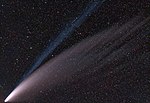astro.wikisort.org - Asteroid
2020 OY4 is a very small asteroid classified as a near-Earth object that passed within 21,850 miles (35,160 km) of the surface of Earth on July 28, 2020, with a fly-by speed of 12.4 kilometres (7.7 mi) per second.[3] The car-sized asteroid posed no risk of impact to Earth, but it did pass within the orbit of satellites in the geostationary ring at 35,785 kilometres (22,236 mi) above Earth's equator.[4]
| Discovery [1][2] | |
|---|---|
| Discovered by | MLS |
| Discovery site | Mount Lemmon Obs. |
| Discovery date | July 26, 2020 |
| Designations | |
MPC designation | 2020 OY4 |
Minor planet category | NEO · Apollo [1][2] |
| Orbital characteristics [2] | |
| Epoch 31 May 2020 (JD 2459000.5) | |
| Uncertainty parameter 6[2] · 7[1] | |
| Observation arc | 2 days |
| Aphelion | 1.5623 AU |
| Perihelion | 0.6873 AU |
Semi-major axis | 1.1248 AU |
| Eccentricity | 0.3889 |
Orbital period (sidereal) | 1.19 yr (436 d) |
Mean anomaly | 257.94° |
Mean motion | 0° 49m 34.32s / day |
| Inclination | 2.1148° |
Longitude of ascending node | 305.50° |
Argument of perihelion | 98.703° |
| Earth MOID | 0.0000879 AU (0.034 LD) |
| Physical characteristics | |
Mean diameter | 2–5 m[3] |
Absolute magnitude (H) | 30.18[2] 30.35[1] |
The asteroid was discovered July 26, 2020 using the Mount Lemmon Survey telescope in the Santa Catalina Mountains northeast of Tucson, Arizona.[3] The next encounter closer than the Moon is predicted to occur July 30, 2055 at a distance of 200,000 kilometres (124,000 mi) or more.[2]
References
- "2020 OY4". Minor Planet Center. Retrieved 9 September 2020.
- "JPL Small-Body Database Browser: (2020 OY4)" (2020-07-28 last obs.). Jet Propulsion Laboratory. Retrieved 9 September 2020.
- "CAFS for 2020 OY4". ESA's NEO Coordination Centre. Retrieved July 28, 2020.
- Malik, Tariq (July 28, 2020). "An asteroid the size of a car just zipped by Earth in close flyby". Space.com.
External links
- 2020 OY4 at NeoDyS-2, Near Earth Objects—Dynamic Site
- Ephemeris · Obs prediction · Orbital info · MOID · Proper elements · Obs info · Close · Physical info · NEOCC
- 2020 OY4 at ESA–space situational awareness
- 2020 OY4 at the JPL Small-Body Database
Текст в блоке "Читать" взят с сайта "Википедия" и доступен по лицензии Creative Commons Attribution-ShareAlike; в отдельных случаях могут действовать дополнительные условия.
Другой контент может иметь иную лицензию. Перед использованием материалов сайта WikiSort.org внимательно изучите правила лицензирования конкретных элементов наполнения сайта.
Другой контент может иметь иную лицензию. Перед использованием материалов сайта WikiSort.org внимательно изучите правила лицензирования конкретных элементов наполнения сайта.
2019-2025
WikiSort.org - проект по пересортировке и дополнению контента Википедии
WikiSort.org - проект по пересортировке и дополнению контента Википедии


